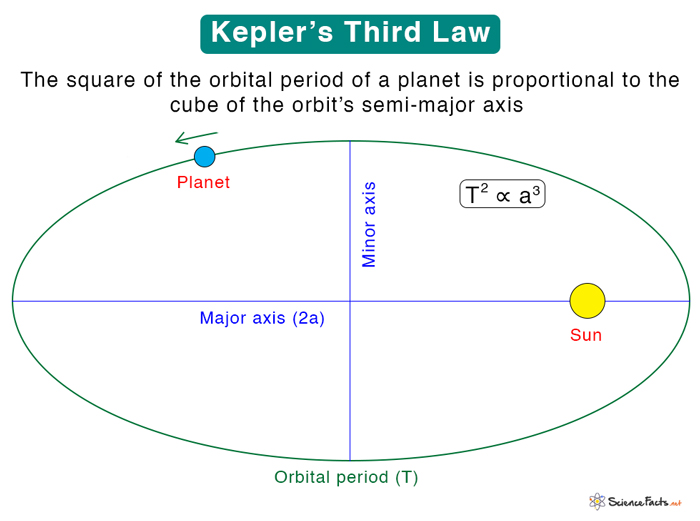
- Why Does Water Expand When It Freezes
- Gold Foil Experiment
- Faraday Cage
- Oil Drop Experiment
- Magnetic Monopole
- Why Do Fireflies Light Up
- Types of Blood Cells With Their Structure, and Functions
- The Main Parts of a Plant With Their Functions
- Parts of a Flower With Their Structure and Functions
- Parts of a Leaf With Their Structure and Functions
- Why Does Ice Float on Water
- Why Does Oil Float on Water
- How Do Clouds Form
- What Causes Lightning
- How are Diamonds Made
- Types of Meteorites
- Types of Volcanoes
- Types of Rocks

Kepler’s Third Law
Kepler’s third law states “ The square of a planet’s orbital period is directly proportional to the cube of the orbit’s semi-major axis “.
Kepler’s third law establishes a relationship between the time taken by a planet to complete one revolution and its distance from the Sun. According to this law, the orbital period increases rapidly with the orbit’s radius.
The importance of the third law is that it has been successful in measuring the masses of the planets in the solar system. This law can also be applied to planets beyond the solar system, asteroids, comets, and artificial satellites. Another name for Kepler’s third law is the law of harmony.

German astronomer and mathematician Johannes Kepler published this law in 1619.
Kepler’s third law establishes the relationship between the orbital period and the distance of a planet’s orbit from the Sun. Kepler stated in his first law that the planets move around the Sun in elliptical orbits. The orbit’s size is represented by the semi-major axis a . Suppose T is the orbital period. Then, according to this law,
Where k is the constant of proportionality.
Newton showed in 1687 that Kepler’s third law was a direct consequence of his laws of motion and his law of gravity. To prove this and make the derivation easier, we make a few assumptions:
- The planets’ orbits are circular rather than elliptical.
- The Sun is at the center of the orbits rather than the focus.
Newton’s law of gravity states that the force of attraction between the Sun and a planet is given by
M s : Sun’s mass
M p : Planet’s mass
R : Distance between the planet and Sun
G : Universal gravitational constant.
In this case, R is assumed to be the radius of the orbit.
When an object moves in a circle, there will be a centripetal force . When a planet moves with a velocity V , the centripetal force F C is given by
The gravitational force provides the centripetal force. Therefore,
However, the speed V is given by the distance the planet moves divided by the time it takes. For one complete revolution, this is given by
Where 2πR is the circumference and T is the time taken to complete one revolution, known as the orbital period. Substituting for V , we get
Replacing R with the semi-major axis a ,
This equation is the Kepler’s third law, where the constant of proportionality k is given by
Thus, we have derived Kepler’s third law from Newton’s laws of motion and Newton’s law of gravity.
T is expressed in Earth years
a is expressed in astronomical units (AU)
M s is expressed in solar mass or M s = 1

The following table shows the orbital period in years and the semi-major axes in astronomical units (A.U.) of the solar system planets. It is observed that the ratio T 2 /a 3 comes out to be close to 1.
Example Problems
Problem 1 : Kepler’s third law says that T 2 /a 3 is the same for all objects orbiting the Sun. Consider the dwarf planet Ceres in the asteroid belt that takes 4.6 years to orbit the Sun. Calculate the average Sun-Ceres distance.
From Kepler’s third law
Or, a = (T) 2/3
Or, a = (4.6) 2/3
Or, a = 2.77 A.U.
Problem 2 : Jupiter takes 11.86 years to complete one revolution. What is its distance from the Sun in km? (1 A.U. = 1.5 x 10 8 km)
T = 11.86 y
From Kepler’s Law
Or, a = (11.86) 2/3
Or, a = 5.2 A.U. = 5.2 A.U. x 1.5 x 10 8 km/A.U. = 7.6 x 10 8 km
- Kepler’s Third Law: The movement of solar system planets – Space.com
- Kepler’s Three Laws – Physicsclassroom.com
- Kepler’s Third Law – Spiff.rit.edu
- Kepler’s Law – Hyperphysics.phy-astr.gsu.edu
- Kepler’s Third Law – Farside.ph.utexas.edu
Article was last reviewed on Thursday, June 16, 2022
Related articles


Leave a Reply Cancel reply
Your email address will not be published. Required fields are marked *
Save my name, email, and website in this browser for the next time I comment.
Popular Articles

Join our Newsletter
Fill your E-mail Address
Related Worksheets
- Privacy Policy
© 2024 ( Science Facts ). All rights reserved. Reproduction in whole or in part without permission is prohibited.

IMAGES
VIDEO